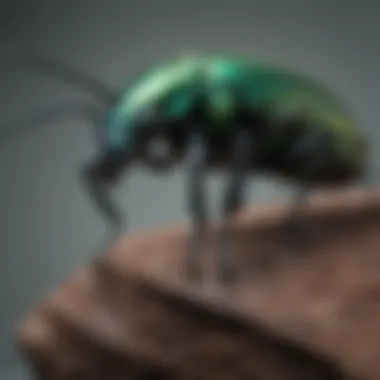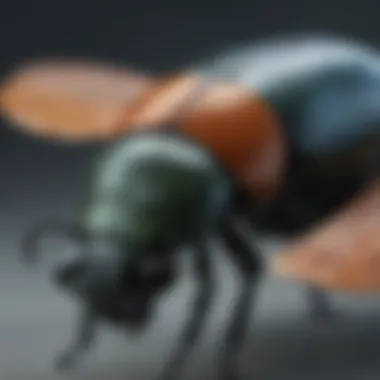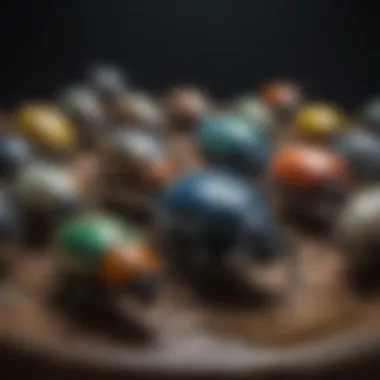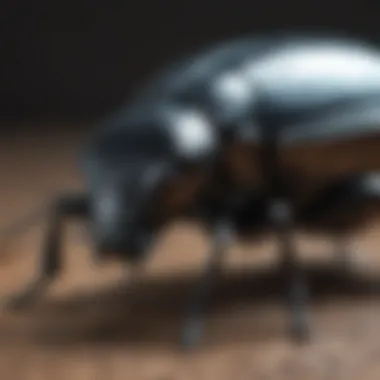Unveiling the Intricacies of Beetles in Taxidermy: A Comprehensive Guide


Animal Species Profile
When embarking on the journey of exploring the world of beetles for taxidermy purposes, an understanding of the beetle species becomes foundational. Beetles belong to the order Coleoptera, encompassing a vast array of species known for their diverse physical characteristics and distribution across different habitats globally. These insects typically exhibit a hard exoskeleton, elytra covering their delicate flying wings, and intricate patterns and colors that make them appealing to taxidermy enthusiasts. Beetles can be found in an extensive range of habitats, from lush forests to arid deserts, showcasing their adaptability and evolutionary success. Their behavior and social interactions vary among species, with some displaying solitary tendencies while others engage in intricate mating rituals and cooperative behaviors within colonies. Understanding the nuances of beetle species is essential for incorporating their beauty into taxidermy projects effectively.
Introduction
In the realm of taxidermy, the world of beetles holds a unique allure that has captivated enthusiasts for generations. Delving into the intricate beauty of beetle specimens, this article aims to shed light on the significance of these fascinating insects in the art of preserving and displaying wildlife. Beetles bring a distinct aesthetic value to taxidermy projects, offering taxidermists a new dimension to explore and incorporate into their creations. Understanding the appeal of beetles goes beyond their physical characteristics; it delves into the symbolic and aesthetic elements that make them a compelling choice for taxidermy practitioners seeking to elevate their skills and artistry.
Understanding the Appeal of Beetles in Taxidermy
The symbolic value of beetles in taxidermy
Beetles hold a symbolic significance in taxidermy that transcends mere representation. Their association with transformation, adaptability, and resilience makes them a poignant choice for taxidermy enthusiasts looking to imbue their creations with deeper meaning. The intricate exoskeletons of beetles symbolize protection and strength, adding a layer of symbolism to taxidermy displays. The symbolic value of beetles offers taxidermists a versatile symbol to convey various themes and emotions in their artwork, making them a valuable asset in the taxidermy world.
The aesthetic allure of beetle specimens
When it comes to aesthetics, beetle specimens stand out for their intricate details, vibrant colors, and unique shapes. The iridescence of beetle wings, the intricate patterns on their bodies, and their diverse sizes make them visually captivating subjects for taxidermy projects. The aesthetic allure of beetle specimens lies in their natural beauty, which can be preserved and showcased in taxidermy displays. Their appeal extends beyond realism; beetles offer taxidermists the opportunity to create visually striking and artistically engaging pieces that combine scientific accuracy with artistic interpretation.


Overview of Beetle Taxidermy
The history of beetle taxidermy
The history of beetle taxidermy dates back centuries, with cultures worldwide incorporating beetles into their artistic and religious practices. Beetles have been prized for their beauty and symbolism, with ancient civilizations using them in jewelry, artifacts, and symbolic representations. The historical significance of beetles in taxidermy showcases their enduring appeal and value as artistic subjects. Understanding the history of beetle taxidermy provides taxidermy enthusiasts with a rich context from which to draw inspiration and deepen their appreciation for these remarkable insects.
Common types of beetles used in taxidermy
In the world of taxidermy, certain beetle species have emerged as favorites for their unique characteristics and suitability for preservation. Beetles such as the Goliath Beetle, Hercules Beetle, and Jewel Beetle are popular choices due to their size, coloration, and availability. These common types of beetles offer taxidermists a diverse palette to work with, allowing for creative experimentation and artistic expression. Understanding the qualities of each beetle species enables taxidermy practitioners to make informed decisions when selecting specimens for their projects.
Collecting Beetles for Taxidermy
Collecting beetles for taxidermy is a crucial aspect of this intricate art, essential for creating stunning displays that captivate viewers. The process of sourcing beetles involves meticulous attention to detail and a deep respect for the specimens. Ethical considerations play a significant role in ensuring the sustainability and legality of acquiring beetle specimens. By prioritizing responsible practices in beetle collection, taxidermy enthusiasts can contribute to the preservation of these magnificent creatures for future generations to appreciate. Understanding the ethical implications of beetle sourcing is fundamental in maintaining the integrity of taxidermy as an art form.
Ethical Considerations in Beetle Sourcing
Sustainable practices in beetle collection
Sustainable practices in beetle collection emphasize the importance of preserving natural habitats and ecosystems. By employing sustainable methods in beetle sourcing, collectors can minimize their environmental impact and promote biodiversity conservation. This approach not only benefits the ecosystem but also ensures the long-term viability of beetle populations for taxidermy enthusiasts. Sustainable practices in beetle collection play a vital role in safeguarding the future availability of beetle specimens for artistic endeavors.


Legality of acquiring beetle specimens
The legality of acquiring beetle specimens is a critical consideration for taxidermy enthusiasts. Adhering to wildlife protection laws and regulations is essential to avoid supporting illegal wildlife trade and exploitation. Understanding the legal aspects of acquiring beetles ensures that collectors operate within ethical boundaries and contribute to the sustainable use of insect specimens. Compliance with legal requirements not only upholds the ethical standards of taxidermy practices but also fosters a sense of responsibility in preserving beetle populations.
Finding High-Quality Beetle Specimens
In the quest for high-quality beetle specimens, taxidermy enthusiasts seek out preferred species renowned for their visual appeal and durability. Selecting the right species for taxidermy projects is crucial for achieving aesthetically pleasing displays that showcase the beauty of beetles. Additionally, tips for locating beetle specimens offer valuable insights into efficient and ethical ways of acquiring specimens. By understanding the traits of preferred species and mastering effective search techniques, collectors can enhance their beetle taxidermy creations with exquisite specimens that stand the test of time.
Preferred species for taxidermy
Preferred species for taxidermy are chosen based on their distinct characteristics, such as vibrant colors, intricate patterns, and size. These species are favored for their suitability in taxidermy displays, enhancing the visual impact of the finished pieces. Collectors carefully select preferred species that align with their artistic vision, ensuring that each beetle specimen contributes to the overall artistic composition.
Tips for locating beetle specimens
Tips for locating beetle specimens encompass various strategies for ethically sourcing specimens, including engaging in responsible collecting practices and utilizing reliable sources. From exploring natural habitats to collaborating with reputable suppliers, collectors can discover a diverse range of beetle specimens for their taxidermy projects. By following expert guidance on locating beetle specimens, enthusiasts can acquire unique and high-quality beetles while supporting sustainable beetle collection practices.
Preparing Beetles for Taxidermy
In the intricate world of taxidermy, preparing beetles plays a crucial role in ensuring the quality and longevity of the end product. Proper preparation techniques not only enhance the aesthetic appeal of the specimens but also contribute to their preservation over time. Understanding the importance of meticulous preparation is paramount for taxidermy enthusiasts looking to create stunning displays that showcase the beauty of beetles in all their glory. From cleaning to preserving, each step in the preparation process demands attention to detail and a meticulous approach, reflecting the dedication and passion of the taxidermist.


Cleaning and Preserving Beetle Specimens
- Methods for Specimen Preservation: When it comes to preserving beetle specimens, taxidermists have a variety of methods at their disposal. Each method offers unique benefits and challenges, influencing the overall outcome of the taxidermy project. Whether opting for traditional preservation techniques or innovative approaches, selecting the right method is essential for maintaining the integrity and appearance of the specimens. By delving into the specifics of each preservation method, taxidermy enthusiasts can make informed decisions that align with their artistic vision and long-term goals.
- Ensuring the Longevity of Beetle Displays: Ensuring the longevity of beetle displays involves more than just preserving the specimens themselves. Factors such as environmental conditions, handling procedures, and display techniques also contribute to the lifespan of the taxidermy creations. By implementing best practices for display maintenance and longevity, taxidermy enthusiasts can safeguard their beetle specimens against deterioration and damage. Maintaining a meticulous care routine helps preserve the beauty and intricacy of the displays, allowing them to be enjoyed for years to come.
Tools and Techniques for Beetle Preparation
As taxidermy artists embark on preparing beetles for display, having the right tools and employing effective techniques are paramount for achieving professional results. Each tool serves a specific purpose in the preparation process, from delicate pins for positioning to precision instruments for manipulation. Understanding the role of each tool and technique empowers taxidermy enthusiasts to execute every step with finesse and precision, bringing their artistic vision to life with meticulous detail.
Essential Tools for Beetle Taxidermy
- Essential tools for beetle taxidermy: An array of essential tools is essential for beetle taxidermy, ranging from pinning boards for specimen positioning to scalpel blades for intricate work. Each tool has a specific function that contributes to the overall preparation process, ensuring that every detail of the specimen is carefully attended to. Investing in quality tools is a worthwhile endeavor for taxidermy enthusiasts looking to elevate their craft and produce exceptional beetle displays.
- Step-by-step Preparation Process: A systematic step-by-step approach is vital for the successful preparation of beetle specimens. From initial cleaning to final positioning, each stage of the process requires precision and attention to detail. By following a structured preparation process, taxidermy artists can streamline their workflow and ensure consistent results across all their creations. Mastering the step-by-step preparation process is key to achieving professional-quality beetle displays that captivate viewers with their exquisite beauty and meticulous craftsmanship.
Displaying Beetle Taxidermy Creations
In the vast realm of taxidermy, displaying beetle specimens holds a significant position that demands attention and finesse. The manner in which these intricate creatures are showcased serves not only to exhibit their beauty but also to convey a story or evoke emotions. Displaying beetle taxidermy creations is an art form in itself, requiring careful consideration of various elements to ensure the optimal presentation and preservation of these unique specimens. Through creative placement and thoughtful curation, taxidermy enthusiasts can elevate the appeal of beetle displays and showcase these fascinating creatures in all their glory.
Creative Presentation Ideas for Beetle Displays
Choosing the right mounting techniques
When it comes to beetle taxidermy, selecting the appropriate mounting techniques plays a pivotal role in the overall aesthetics and longevity of the display. The choice of mounting technique determines how securely the beetle specimen is positioned within the display, ensuring its stability and visual appeal. Opting for the right mounting technique is crucial for showcasing the beetle in its best possible light, allowing viewers to appreciate its intricate details without distractions. Additionally, proper mounting techniques contribute to the overall durability of the display, safeguarding the specimen against damage or deterioration over time.
Incorporating beetles into artistic arrangements
Incorporating beetles into artistic arrangements adds a layer of sophistication and creativity to the display, transforming it into a visually captivating piece of art. By integrating beetles into carefully crafted compositions, taxidermy enthusiasts can create unique and thought-provoking displays that engage the viewer on multiple levels. The strategic placement of beetles within artistic arrangements not only enhances their individual beauty but also contributes to the overall harmony and aesthetic appeal of the display. This innovative approach infuses a sense of artistry and narrative into beetle taxidermy, allowing for endless possibilities in terms of presentation and storytelling.







